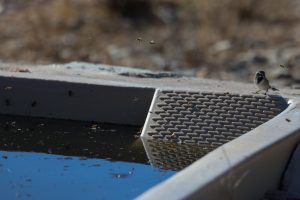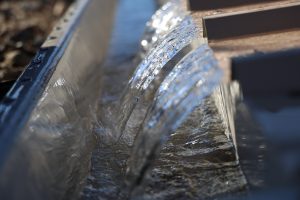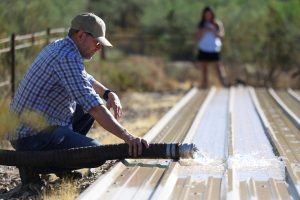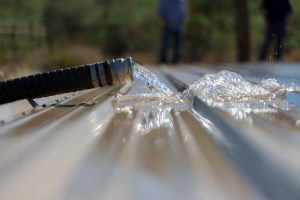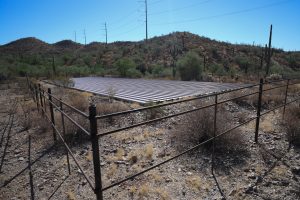- Slug: BC-CNS-Water Catchments. 640 words.
- Photos available (thumbnails, captions below).
- Audio story available here. (Note: Some web browsers may not support media download.)
By Kiersten Edgett
Cronkite News
CAREFREE – At the center of all life is water. But, for wildlife in the hot deserts of Arizona, finding it isn’t so easy. That’s where water catchments come in.
Water catchments are systems that collect rainwater and use it to fill a drinking hole for desert-dwelling animals – from honeybees to bighorn sheep.
According to the Arizona Game and Fish Department, there are roughly 3,000 catchments across Arizona.
A catchment looks like a large tin roof on the ground, with one side at a slight incline, known as an apron. Along the lowest side of the apron is a gutter, which feeds any water caught into large tanks below the tin apron. Water stored in the underground tanks then feeds into and automatically refills a small drinking hole nearby, which looks like a cement hole with a side ramp for smaller animals to take a drink.
The program started in the 1940s, and the catchments are managed by three different agencies – Arizona Game and Fish, the U.S. Forest Service and the Bureau of Land Management.
Although some of the water catchment systems are self-sustaining, others require refills using large water trucks, hauling up to 1,700 gallons of water.
Joseph Currie, habitat planning program manager with Arizona Game and Fish, said 2023 was different from past years.
“This summer was not as bad for us, for hauling water, and the only reason was because we had that really wet and cool winter and spring,” Currie said, noting many of the catchments filled up naturally. “We didn’t haul nearly as much as like a couple years ago, where we had a really bad winter and a really bad summer.”
Currie said Arizona Game and Fish hauled an estimated 1 million gallons of water this year. During drier years, the agency has hauled up to 2.6 million gallons. Currie said wildlife used water catchments heavily throughout July and August, when Arizona saw record-breaking temperatures.
“Our summers are super hot and dry, and populations will fluctuate and die off drastically if we’re not able to give them a stable source of water, because water is the most important thing in life,” Currie said.
Nate Solmon, habitat construction field crew supervisor with Arizona Game and Fish, said where the water comes from varies and can include places such as fire departments close to the catchment sites.
“The hardest part is figuring out the logistics and then also where we’re going to get the water from,” Solmon said, noting locations can range from further north Arizona to close to the border.
Solmon’s team that fills the catchments runs on an eight-day-long shift, keeping their gear in the truck and camping near places where catchments may need to be filled. Arizona Game and Fish uses an electronic frequency system to measure the water levels of the catchments, which sends alerts to Game and Fish officials when the levels get too low.
Some days, Solmon’s team drives the water truck up to the site, empties the water tank onto the catchment apron and then waits for the next call. However, for places too difficult to reach using just the water truck, it could require the help of a helicopter.
“We’ll truck water out, we have to find a staging area – we have to try to get as close to the catchment as we can because obviously helicopters are really expensive,” Solmon said of the process with helicopter support. The helicopter then picks up a large tank of water and dumps it onto the apron.
Depending on the temperature, local wildlife and catchment system, Solmon’s team could be taking trips to a specific catchment every four to six weeks.
Arizona Game and Fish currently builds one or two new catchments each year but is primarily focusing on making existing catchments self-sustaining.
For more stories from Cronkite News, visit cronkitenews.azpbs.org.
